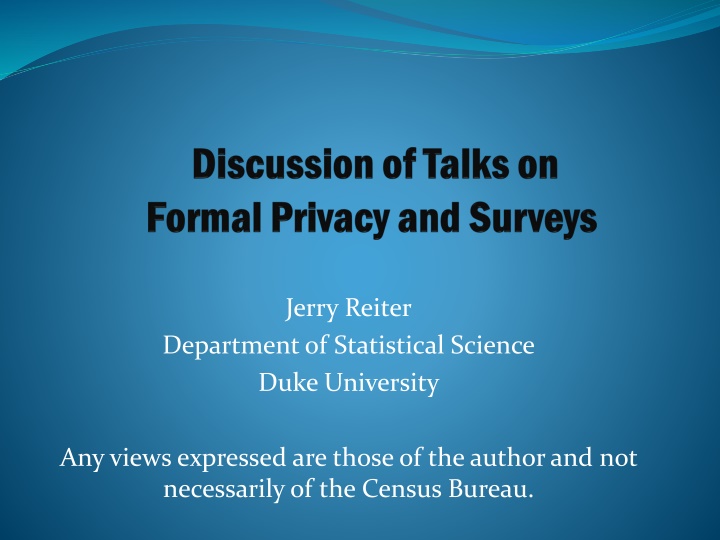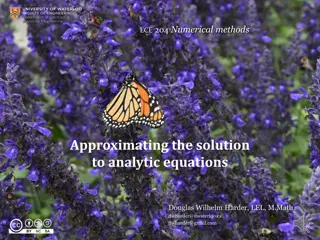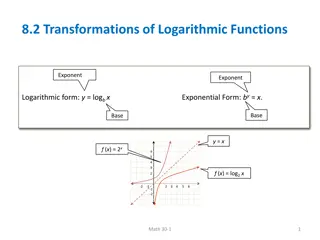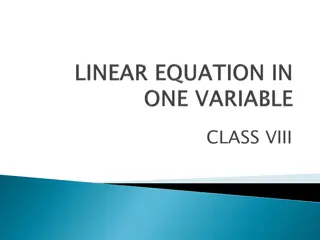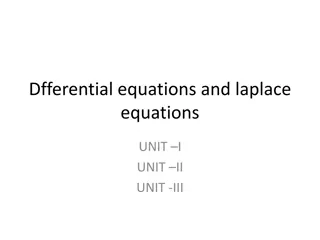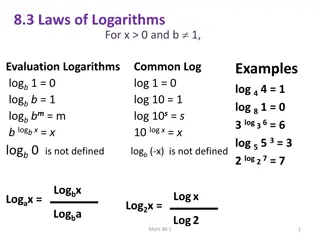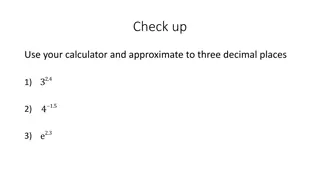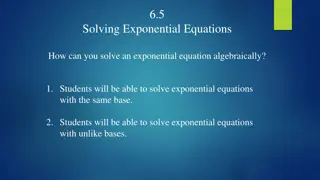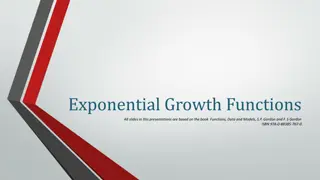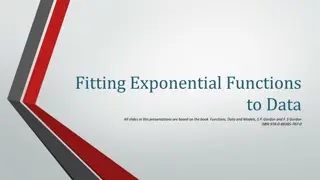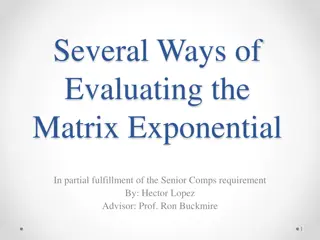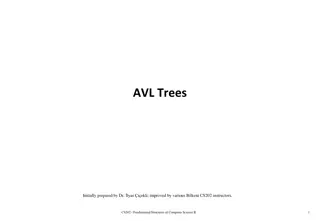Exponential and Logarithmic Equations Exploration
Discover the principles of solving exponential and logarithmic equations with examples and step-by-step guides. Learn how to manipulate expressions on both sides to find the variable. Utilize logarithms to simplify exponential equations effectively.
Download Presentation

Please find below an Image/Link to download the presentation.
The content on the website is provided AS IS for your information and personal use only. It may not be sold, licensed, or shared on other websites without obtaining consent from the author.If you encounter any issues during the download, it is possible that the publisher has removed the file from their server.
You are allowed to download the files provided on this website for personal or commercial use, subject to the condition that they are used lawfully. All files are the property of their respective owners.
The content on the website is provided AS IS for your information and personal use only. It may not be sold, licensed, or shared on other websites without obtaining consent from the author.
E N D
Presentation Transcript
Jerry Reiter Department of Statistical Science Duke University Any views expressed are those of the author and not necessarily of the Census Bureau.
Talks I will discuss today Aref Dajani. Adapting Surveys for Formal Privacy: Where We Are, Where We Are Going. Mark Bun, J rg Drechsler, Marco Gaboardi, Audra McMillan, Jayshree Sarathy. Controlling Privacy Loss in Survey Sampling: an Analysis of Stratified and Cluster Sampling.
Big picture remarks on Dajanis talk Census Bureau and formal privacy: innovative, leading edge, and commendable. Big kudos for accurate interpretations of DP definition DP bounds the change in the inference made about a person or establishment, whether that person/establishment chooses to participate in the survey and is included in the data or not. It is not possible to responsibly disseminate information products from any survey or census with no disclosure risk.
Dajani: Specific thoughts 1 represents a bound on the incremental risk. Just because a release is DP does not mean an agency should disregard disclosure risk assessments. Large like those used in practical applications could come with disclosure risks. Two DP algorithms with the same could have different disclosure risk properties for different kinds of attacks. We need statistical disclosure risk measures that account for formal privacy protections Bayesian approaches (e.g., Reiter 2005) offer paths forward. But much work to be done .
Dajani: Specific thoughts 2 Tension between the principled and the practical For now, it seems that the Census Bureau may not strictly enforce a privacy budget for all queries of a database (e.g., GASP may not be formally private). Sometimes one has to get things done! What are the implications for disclosure risk of releasing a mix of formally private and not formally private statistics?
Dajani: Specific thoughts 3 Disclosure risk assessments often focus on risks that individuals can be re-identified/participated in a database. For many government surveys and censuses, why should participation be confidential? Does someone knowing that I participated in the ACS have any implication for my well being? Laws written in terms of re-identification, but perhaps those should be revisited An intruder knowing if someone is a member of a dataset may matter for some databases, but need it be the default? Perhaps it is time for more focus on attribute disclosures than re-identification disclosures.
Big picture remarks on Buns et al. talk Investigating DP in complex surveys: moving from hypothetical to practical. (A good thing!) Considering privacy at the design stage, not after the data are collected. (Another good thing!) Providing guidance one what kinds of designs might allow for privacy amplification and what might not, and how old intuition from survey sampling may not apply with formal privacy considerations. (A trifecta!)
Bun et al: Specific thoughts 1 Privacy amplification happens with simpler designs. DP is also easier to implement without high variance survey weights typical of complex surveys. Should we rethink the use of complex survey designs for some data products, especially those intended primarily for secondary research? Might the negative effects of privacy protection on inferential accuracy outweigh the efficiency gains from using a complex sampling design?
Bun et al: Specific thoughts 2 Suppose people/establishments are not secretive about their survey participation. Neighbors, employers, or partners know individuals who participated in a survey. Individuals reveal survey participation on social media. How does one characterize the privacy amplification when part of the sample is secret and part is not? What does privacy amplification mean if we no longer are required to protect membership in a survey?
Final thoughts on the papers I congratulate the presenters on their thought-provoking work, and I look forward to seeing their work develop further. Thank you to the audience for attending our session.
